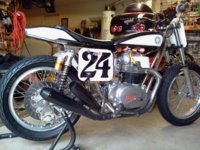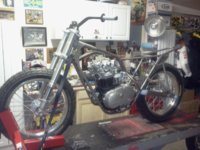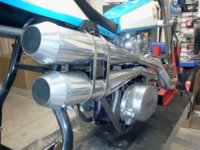Champion750
XS650 Addict
Any racers out there?
I am starting a build on a xs650 based engine that will be used exclusively for flat track racing. I'm experienced at engine building/tuning but this is my first xs650. I have been doing a lot of research but I've been coming up a little short on which ignition system to use. The engine I'm starting with is a 1980 unit out of a "special". Stock ignition is electronic and I'd like to stick with electronic for its reliability mostly. I would also like to run without a battery or electric/kick starter to save weight.
There's a few systems out there to choose from but are there any that are more suitable for racing than others? Also, would one of these PMA alternators be an improvement over the stock 1980 unit (I know very little about the nature of the stock alternator/stator unit). Some say there is a worth while weight savings with these new PMA alternators. Just the fact that they don't need a battery to operate is a plus. I may also try to set up this engine with a remote starter so the flywheel and or rotor used will influence this.
So far all the electronic systems I'm seeing have fixed advance curves. Does anyone make one with a variable curve? If all the aftermarket systems have fixed curves, would a new set up be any improvement over stock as far as power output? Also I have not run my engine yet, I bought it in parts but the previous owner was riding the bike before he took it apart so I'm assuming the ignition system works. Is it possible to run stock 1980 electronic ignition without a battery? I have Craig Weeks manual but some of these questions he does not specifically address.
Also, do any of these aftermarket systems that utilize electronic advance curves improve performance and in what way?
Any help would be appreciated.
Thanx,
Robert
...its ok, you can make fun of me if I overlooked anything obvious
I am starting a build on a xs650 based engine that will be used exclusively for flat track racing. I'm experienced at engine building/tuning but this is my first xs650. I have been doing a lot of research but I've been coming up a little short on which ignition system to use. The engine I'm starting with is a 1980 unit out of a "special". Stock ignition is electronic and I'd like to stick with electronic for its reliability mostly. I would also like to run without a battery or electric/kick starter to save weight.
There's a few systems out there to choose from but are there any that are more suitable for racing than others? Also, would one of these PMA alternators be an improvement over the stock 1980 unit (I know very little about the nature of the stock alternator/stator unit). Some say there is a worth while weight savings with these new PMA alternators. Just the fact that they don't need a battery to operate is a plus. I may also try to set up this engine with a remote starter so the flywheel and or rotor used will influence this.
So far all the electronic systems I'm seeing have fixed advance curves. Does anyone make one with a variable curve? If all the aftermarket systems have fixed curves, would a new set up be any improvement over stock as far as power output? Also I have not run my engine yet, I bought it in parts but the previous owner was riding the bike before he took it apart so I'm assuming the ignition system works. Is it possible to run stock 1980 electronic ignition without a battery? I have Craig Weeks manual but some of these questions he does not specifically address.
Also, do any of these aftermarket systems that utilize electronic advance curves improve performance and in what way?
Any help would be appreciated.
Thanx,
Robert
...its ok, you can make fun of me if I overlooked anything obvious




